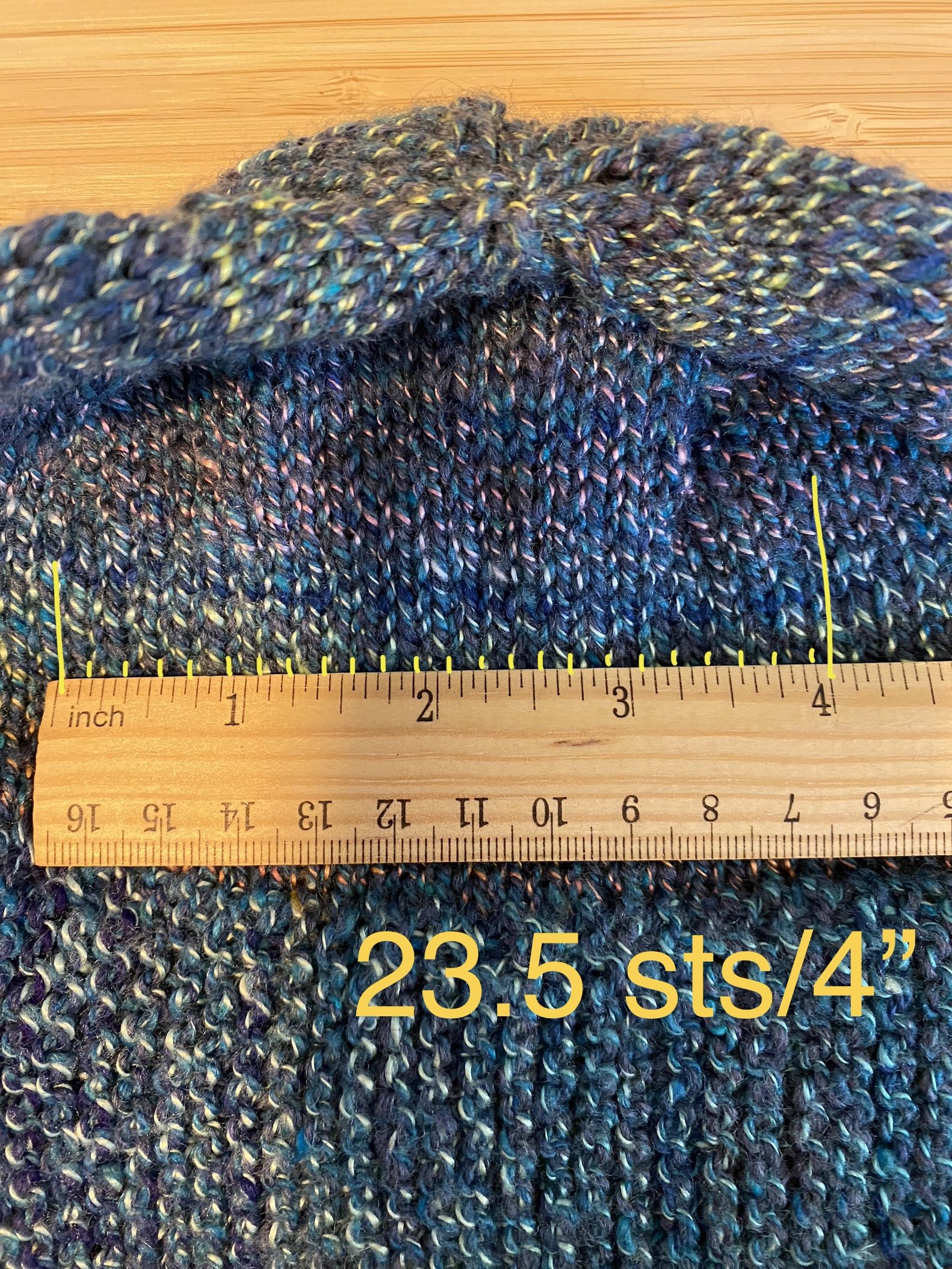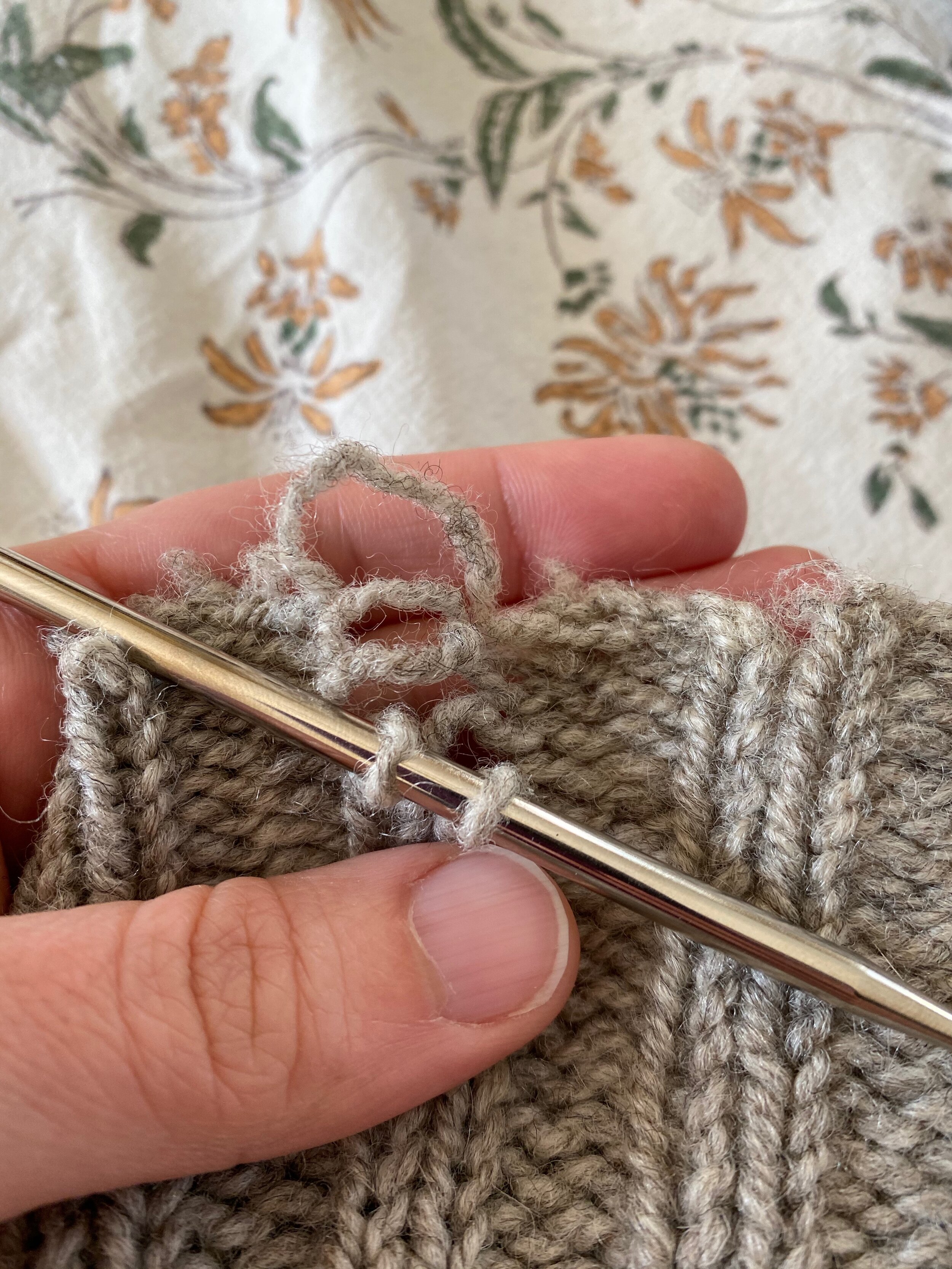Use Knittrick’s Adjust a Pattern option when you want to change the stitch and row counts in a pattern to work with your own gauge, whether you’re using a slightly different yarn than the pattern calls for or just don’t knit the specified yarn at exactly the gauge the pattern expects. Either way, it’s safest to use a gauge that’s pretty close to the original.
For an example, let’s look at the free, one-size-fits-all 1898 Hat pattern, which you can find in the Patterns section of the The Seamen’s Church Institute’s website. I bought a beautiful skein of handspun at a craft fair last year and wanted to make this hat out of it. The only problem was that the pattern calls for a gauge of 20 stitches per 4 inches, and my yarn came out at 23.5 stitches per 4 inches.
Yes, I’m measuring the finished hat here. Because I don’t have a gauge swatch. I wish I could say that was because I unraveled my swatch to use up every bit of this precious yarn, but the truth is that I was lazy and impatient and figured I would start the hat band and use that as my gauge swatch. That was a mistake - the gauge I read from the garter stitch with slip stitch ridge in the middle was not accurate at all and I ended up having to recalculate/compensate on the fly… The point is, take the time to knit a real swatch and measure your gauge carefully! But also, knitting is fun and hats are forgiving, so if you make the same mistake I did, I bet you can make it work. :)
After you’ve measured your gauge, you’ll need to find the key stitch counts in the pattern that will need to be adjusted. In this pattern, there is a cast on count of 27 stitches for the hat band, and then increase rows that bring that count to 45 stitches at the widest part of the earflap. Then for the crown of the hat, you pick up 84 stitches from the edge of the band.
The “Difference” column tells you how far off the final measurement you get by following Knittrick’s recommendations will be from the pattern’s intention. In this case, because the gauge is fairly fine and there are no pattern repeats to contend with, those differences are tiny.
With this information, you can make notes for yourself in the pattern and start knitting. Where the pattern says to cast on 27 stitches, you would cast on 32. And where the pattern says to work 9 increase rows to get to 45 stitches, you would work 10 increase rows to get to 52 (or 11 to get to 54, depending on whether you wanted barely shorter earflaps or barely longer ones). And your whole hat band should end up having the correct number of rows to pick up 99 stitches for the crown instead of 84 stitches like the pattern says. You can might figure out that means 198 rows, since the pattern wanted twice as many rows as stitches to pick up later, but you can also use Knittrick to keep track of row calculations.
To keep your row and stitch calculations separate, use the toggle at the top left of the screen. For this pattern, the garter stitch band should be worked in pairs of two rows to make a complete garter ridge to pick up from later. So turn on the “Require whole repeats” option and enter 2 rows as the repeat amount.
You can see that even for a simple project like this hat, there are a number of different things to keep in mind when altering the gauge, and it is important to understand how the piece is constructed so that you can tell which counts are key and how they might interact with each other. If you are knitting a multisize pattern, you will probably find it easier to to just choose a different size and follow the instructions for that instead of doing all the individual calculations yourself. Knittrick can help with that, too - check out the Pick a Pattern Size post for guidance!
A final note: Making big changes in gauge will make big changes in the nature of the finished object. Knittrick can only convert the flat dimensions of a project (the width, length, or circumference). It can’t make adjustments for the thickness of the fabric you’ll be creating. So, you can use Knittrick to tell you how many bulky stitches to cast on for a baby sweater pattern that calls for lightweight yarn, but the resulting sweater will be really thick and probably not very comfortable! The Craft Yarn Council has a helpful guide to yarn weights, if you want to learn more.
















































